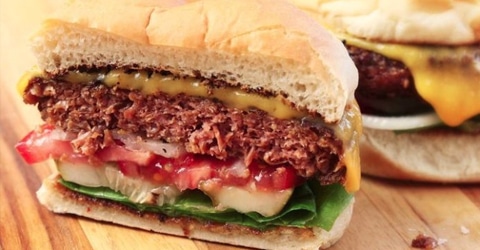

Meat alternatives like the Beyond Burger and Impossible Burger are taking restaurants around the world by storm. Today, it’s not unusual to find these vegan options on the menu at well-known chains like Burger King, Red Robin, Cheesecake Factory, TGI Friday’s and Tim Hortons,[1] and many people see the growing popularity as a positive move away from the consumption of animal foods.
But how do Beyond and Impossible stack up from a health perspective? If your goal is to stick to a whole food, plant-based (WFPB) diet, you might want to take a closer look before sinking your teeth into these beefless patties.
When you check out the labels of burgers from Beyond Meat and Impossible Foods, here’s what you’ll find:
| Beyond Burger | Impossible Burger |
| Ingredients: Water, Pea Protein Isolate, Expeller-Pressed Canola Oil, Refined Coconut Oil, Contains 2% or less of the following: Cellulose from Bamboo, Methylcellulose, Potato Starch, Natural Flavor, Maltodextrin, Yeast Extract, Salt, Sunflower Oil, Vegetable Glycerin, Dried Yeast, Gum Arabic, Citrus Extract (to protect quality), Ascorbic Acid (to maintain color), Beet Juice Extract (for color), Acetic Acid, Succinic Acid, Modified Food Starch, Annatto (for color) | Ingredients: Water, Soy Protein Concentrate, Coconut Oil, Sunflower Oil, Natural Flavors, 2% or less of: Potato Protein, Methylcellulose, Yeast Extract, Cultured Dextrose, Food Starch Modified, Soy Leghemoglobin, Salt, Soy Protein Isolate, Mixed Tocopherols (Vitamin E), Zinc Gluconate, Thiamine Hydrochloride (Vitamin B1), Sodium Ascorbate (Vitamin C), Niacin, Pyridoxine Hydrochloride (Vitamin B6), Riboflavin (Vitamin B2), Vitamin B12 |
| Nutrition: 290 calories, 22 grams fat, 5 grams saturated fat, 450 milligrams sodium, 20 grams protein | Nutrition: 240 calories, 14 grams fat, 8 grams saturated fat, 370 milligrams sodium, 19 grams protein |
For comparison, a quarter-pound McDonald’s burger patty without a bun, toppings or cheese has 210 calories, 15 grams of fat, 7 grams of saturated fat, 55 milligrams of sodium and 12 grams of protein. (McDonald’s burgers also contain small amounts of cholesterol and trans fats, neither of which are present in plant-based burgers.) Although the bun and condiments with which the patty is served have fairly extensive ingredient lists, the patty has just one component: beef.[2]
Neither Beyond nor Impossible products are meant to be staples of any diet.
Ethical and environmental issues of meat production aside, it’s difficult to ignore the number and nature of the ingredients necessary to reproduce the taste and texture of a single-ingredient food. Aside from water, just about everything in the Beyond and Impossible burgers is highly processed, and many ingredients bear a striking resemblance to those often found in foods considered responsible, at least in part, for the current epidemic of obesity and chronic disease affecting numerous populations around the world.
However, both Beyond Meat and Impossible Foods cite the health of the planet as a core part of their missions, and this is where their products significantly outshine animal foods. According to Impossible Foods’ 2019 impact report, their meat alternatives:
Numbers are given in comparison to “even the most environmentally efficient cattle-based production.”[3]
How about the Beyond Burger? Its footprint appears to be even smaller with:
Impact statistics were reported in a study by the Center for Sustainable Systems at the University of Michigan using one-quarter pound of “U.S. beef” as a comparison.[4]
Deriving meat alternatives from plants may do less harm to the environment, but there are still several concerns associated with the ingredients:
In addition, Impossible Burgers contain both genetically modified (GM) soy and a new food additive called leghemoglobin, produced by plants in nature but mass-produced for Impossible products using GM yeast cells.[7] Leghemoglobin is what gives the Impossible Burger its characteristic “bloody” appearance when cooking, but since it hasn’t been on the market very long, there’s little research regarding any long-term impact on health.
Despite the potentially negative health effects of the ingredients, options like those from Beyond Meat and Impossible Foods aren’t without their uses. Remember when you transitioned away from animal products? There were probably some awkward moments when you got invited out to lunch or to a gathering where there was little or nothing you could eat. Or you had a party at your place, and none of your non-vegan friends touched the food. Being able to order a meat-free option or toss a few Beyond patties on the grill eases the social tensions many people feel during the early stages of a lifestyle change.
And, no matter how good you get at meal planning, sometimes life happens. There are emergencies or unexpected changes in schedules that leave you with a growling stomach and few options. It’s unlikely eating an Impossible Burger in one of these rare circumstances is going to cause lasting damage if your normal diet consists mostly of unprocessed plant foods.
However, neither Beyond nor Impossible products are meant to be staples of any diet. Whether you’re WFPB, vegan, or are just starting to decrease the amount of animal foods in your diet, it’s best to think of these meat-free burgers as what they are: processed products best left off your plate the majority of the time.
Although these much-touted meat alternatives aren’t compatible with a WFPB lifestyle, you’re far from out of luck! Unprocessed ingredients like beans, whole grains, veggies, and nuts can come together in endless combinations to make delicious, plant-based burgers. The best part? They’re completely customizable to your tastes and can be frozen so that they’re ready to enjoy any time. Check out this guide to building the ultimate plant-based burger to get started with your own meat alternatives.
Revised 11/1/19: The original version of this article mistakenly cited the nutrition facts for McDonald’s standard burgers instead of the quarter-pounder. The text has been corrected for clarity.
Image Credit: DefimZ / Wikipedia Commons
Copyright 2024 Center for Nutrition Studies. All rights reserved.